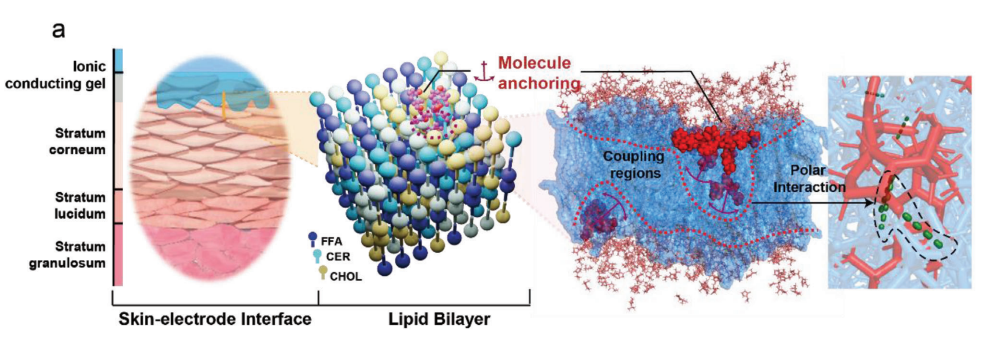Publication
- Enhancing Prosthetic Control through High-Fidelity Myoelectric Mapping with Molecular Anchoring Technology

Myoelectric control utilizes electrical signals generated from the voluntary contraction of remaining muscles in an amputee’s stump to operate a prosthesis. Precise and agile control requires low-level myoelectric signals (below 10% of maximum voluntary contraction, MVC) from weak muscle contractions such as phantom finger or wrist movements, but imbalanced
calcium concentration in atrophic skin can distort the signals. This is due to poor ionic–electronic coupling between skin and electrode, which often causes excessive muscle contraction, fatigue, and discomfort during delicate tasks. To overcome this challenge, a new strategy called molecular anchoring is developed to drive hydrophobic molecular effectively interact with and embed into stratum corneum for high coupling regions between ionic fluxes and electronic currents. The use of hydrophobic poly(N-vinyl caprolactam) gel has resulted in an interface impedance of 20 k𝛀, which is 1/100 of a commercial acrylic-based electrode, allowing the detection of ultralow myoelectric signals (≈1.5% MVC) that approach human limits. With this molecular anchoring technology, amputees operate a prosthesis with greater dexterity, as phantom finger and wrist movements are predicted with 97.6% accuracy. This strategy provides the potential for a comfortable human–machine interface when amputees accomplish day-to-day tasks through precise and dexterous myoelectric control.
Researcher/Author: Liang Pan, Hui Wang, Pingao Huang, Xuwei Wu, Zihan Tang, Ying Jiang, Shaobo Ji,
Jinwei Cao, Baohua Ji, Guanglin Li,* Dechang Li,* Zhiming Wang,* and Xiaodong Chen*
Published in: Published online: 2023 IEEE 73rd Electronic Components and Technology Conference
For paper download, goto: 10.1002/adma.202301290
- Home
- Enhancing Prosthetic Control through High-Fidelity Myoelectric Mapping with Molecular Anchoring Technology
Singapore Hybrid-Integrated Next-Generation μ-Electronics (SHINE) Centre
- Block E6, #E6-5-3, 5 Engineering Drive 1, Singapore 117608
- +65 6601 8522
- shine@nus.edu.sg

